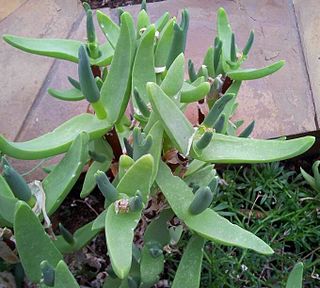The lizard catshark is a small shark species of the catshark family, Scyliorhinidae, found off the coast of southern Brazil on the upper continental shelf at depths of between 250 and 500 metres.

The African sawtail catshark is a species of catshark, part of the family Scyliorhinidae. Demersal in nature, it is found at depths of 160–720 m (520–2,360 ft) off the western African coast from Morocco to South Africa. This slender species has a rather long, pointed snout, a series of dark saddles along the back and tail, and a prominent crest of enlarged dermal denticles along the upper edge of the caudal fin. Its maximum known length is 46 cm (18 in).

The orange wall sponge is a species of sea sponge belonging to the order Trachycladida. It is found in the south Atlantic and Indo-Pacific oceans. Around the South African coast, it is known from the Cape Peninsula to Cape Agulhas.

Haliclona anonyma, the turret sponge or tubular fan sponge, is a species of demosponge. It is endemic to South Africa, where it occurs between the Cape Peninsula and Sodwana Bay.

Haliclona stilensis, the encrusting turret sponge, is a species of demosponge. It is known around the southern African coast, from Namibia to the South African south coast.

Myxilla incrustans is a species of demosponge. It is an encrusting species and is usually yellow.

Genypterus capensis, commonly known as kingklip, is a species of cusk eel occurring along the Southern African coast from Walvis Bay in Namibia to Algoa Bay in South Africa. It is closely related to Genypterus blacodes from New Zealand. The species grows to a maximum length of 180 cm, a weight of 15.0 kg. It is one of the most popular fish items on South African menus. Despite appearances, it is not closely related to the eels of the order Anguilliformes.
Neopetrosia subtriangularis is a species of marine petrosiid sponges native to the waters off Florida and the Caribbean Sea. They superficially resemble staghorn corals.

Mitrophyllum is a genus of succulent plants of the family Aizoaceae, indigenous to the arid region around the Richtersveld, on the border of South Africa and Namibia.

Sepia orbignyana, the pink cuttlefish, is a species of small cuttlefish from the family Sepiidae. It is occurs in the temperate and tropical waters of the eastern Atlantic Ocean.

The marine ecoregions of the South African exclusive economic zone are a set of geographically delineated regions of similar ecological characteristics on a fairly broad scale, covering the exclusive economic zone along the South African coast.
Hamacantha esperoides is a species of demosponge. It is commonly known as the fibrous sponge. It occurs off the southern and western coasts of South Africa, off the coast of Namibia, and off the southeast coast of South America.
Inflatella belli, or the gooseberry sponge, is a species of demosponge that appears to be restricted to the southern hemisphere, where it is widespread. It occurs from the coast of Namibia and the Indo-pacific, down to the Subantarctic and Antarctic regions.
Clathria lissoclada, the triangular blade sponge, is a species of demosponge from the southern hemisphere.
Mycale anisochela, the brain sponge, is a species of demosponge from South Africa and Namibia.
Polymastia bouryesnaultae, the knobbly sponge, is a small and cryptic species of demosponge from South Africa and Namibia.
Suberites dandelenae, the amorphous solid sponge, is a species of deep-sea demosponge from South Africa and Namibia.
Penares sphaera, the crater sponge, is a deep sea demosponge from southern Africa.
Tetilla capillosa, the furry sponge, is a species of demosponge from southern Africa.
Rossella antarctica is a relatively small species of glass sponge. It is widely distributed in the southern hemisphere, particularly in the Antarctic and sub-Antarctic regions.








